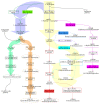Immunomodulatory effects mediated by serotonin
- PMID: 25961058
- PMCID: PMC4417587
- DOI: 10.1155/2015/354957
Immunomodulatory effects mediated by serotonin
Abstract
Serotonin (5-HT) induces concentration-dependent metabolic effects in diverse cell types, including neurons, entherochromaffin cells, adipocytes, pancreatic beta-cells, fibroblasts, smooth muscle cells, epithelial cells, and leukocytes. Three classes of genes regulating 5-HT function are constitutively expressed or induced in these cells: (a) membrane proteins that regulate the response to 5-HT, such as SERT, 5HTR-GPCR, and the 5HT3-ion channels; (b) downstream signaling transduction proteins; and (c) enzymes controlling 5-HT metabolism, such as IDO and MAO, which can generate biologically active catabolites, including melatonin, kynurenines, and kynurenamines. This review covers the clinical and experimental mechanisms involved in 5-HT-induced immunomodulation. These mechanisms are cell-specific and depend on the expression of serotonergic components in immune cells. Consequently, 5-HT can modulate several immunological events, such as chemotaxis, leukocyte activation, proliferation, cytokine secretion, anergy, and apoptosis. The effects of 5-HT on immune cells may be relevant in the clinical outcome of pathologies with an inflammatory component. Major depression, fibromyalgia, Alzheimer disease, psoriasis, arthritis, allergies, and asthma are all associated with changes in the serotonergic system associated with leukocytes. Thus, pharmacological regulation of the serotonergic system may modulate immune function and provide therapeutic alternatives for these diseases.
Figures

Similar articles
-
Role of serotonin receptor signaling in cancer cells and anti-tumor immunity.Theranostics. 2021 Mar 11;11(11):5296-5312. doi: 10.7150/thno.55986. eCollection 2021. Theranostics. 2021. PMID: 33859748 Free PMC article. Review.
-
The role of serotonin and its receptors in activation of immune responses and inflammation.Acta Physiol (Oxf). 2015 Mar;213(3):561-74. doi: 10.1111/apha.12430. Epub 2014 Dec 11. Acta Physiol (Oxf). 2015. PMID: 25439045 Review.
-
[Serotonergic regulation of the immune system].Usp Fiziol Nauk. 2014 Oct-Dec;45(4):69-88. Usp Fiziol Nauk. 2014. PMID: 25729845 Review. Russian.
-
Serotonin transport and serotonin transporter-mediated antidepressant recognition are controlled by 5-HT2B receptor signaling in serotonergic neuronal cells.FASEB J. 2006 Sep;20(11):1843-54. doi: 10.1096/fj.06-5724com. FASEB J. 2006. PMID: 16940156
-
Serotonin mechanisms in heart valve disease II: the 5-HT2 receptor and its signaling pathway in aortic valve interstitial cells.Am J Pathol. 2002 Dec;161(6):2209-18. doi: 10.1016/S0002-9440(10)64497-5. Am J Pathol. 2002. PMID: 12466135 Free PMC article.
Cited by
-
Rotavirus and Serotonin Cross-Talk in Diarrhoea.PLoS One. 2016 Jul 26;11(7):e0159660. doi: 10.1371/journal.pone.0159660. eCollection 2016. PLoS One. 2016. PMID: 27459372 Free PMC article.
-
Effect of N-Feruloylserotonin and Methotrexate on Severity of Experimental Arthritis and on Messenger RNA Expression of Key Proinflammatory Markers in Liver.J Immunol Res. 2016;2016:7509653. doi: 10.1155/2016/7509653. Epub 2016 Jul 31. J Immunol Res. 2016. PMID: 27556049 Free PMC article.
-
Profound Properties of Protein-Rich, Platelet-Rich Plasma Matrices as Novel, Multi-Purpose Biological Platforms in Tissue Repair, Regeneration, and Wound Healing.Int J Mol Sci. 2024 Jul 19;25(14):7914. doi: 10.3390/ijms25147914. Int J Mol Sci. 2024. PMID: 39063156 Free PMC article. Review.
-
Identification and investigation of depression-related molecular subtypes in inflammatory bowel disease and the anti-inflammatory mechanisms of paroxetine.Front Immunol. 2023 Feb 27;14:1145070. doi: 10.3389/fimmu.2023.1145070. eCollection 2023. Front Immunol. 2023. PMID: 36923403 Free PMC article.
-
Inhibition of MARK4 by serotonin as an attractive therapeutic approach to combat Alzheimer's disease and neuroinflammation.RSC Med Chem. 2022 Apr 20;13(6):737-745. doi: 10.1039/d2md00053a. eCollection 2022 Jun 22. RSC Med Chem. 2022. PMID: 35814926 Free PMC article.
References
-
- Steiner J., Walter M., Gos T., et al. Severe depression is associated with increased microglial quinolinic acid in subregions of the anterior cingulate gyrus: evidence for an immune-modulated glutamatergic neurotransmission? Journal of Neuroinflammation. 2011;8, article 94 doi: 10.1186/1742-2094-8-94. - DOI - PMC - PubMed
-
- Murphy D. L., Andrews A. M., Wichems C. H., Li Q., Tohda M., Greenberg B. Brain serotonin neurotransmission: an overview and update with an emphasis on serotonin subsystem heterogeneity, multiple receptors, interactions with other neurotransmitter systems, and consequent implications for understanding the actions of serotonergic drugs. Journal of Clinical Psychiatry. 1998;59(15):4–12. - PubMed
Publication types
MeSH terms
Substances
LinkOut - more resources
Full Text Sources
Other Literature Sources
Research Materials

